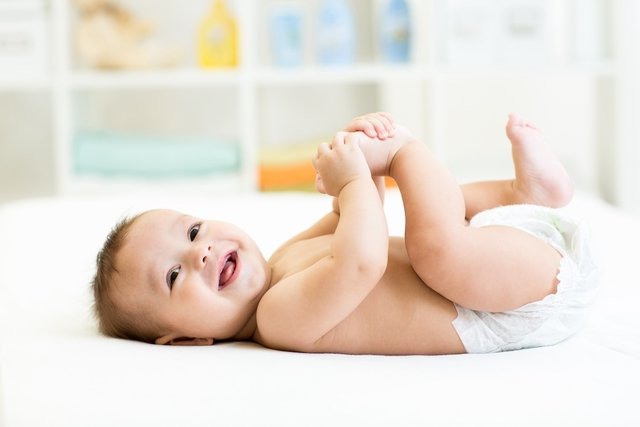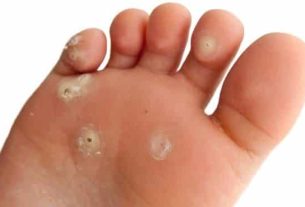Diaper dermatitis is an inflammatory reaction on the baby’s skin that is in contact with the diaper, such as the buttocks, genital region, thighs or waist, causing symptoms such as redness, peeling, itching or pain in the skin.
This inflammation, also known as diaper rash, is the most common cause of dermatitis in babies, occurring due to excess moisture in the region, contact with urine or feces, or allergy to the diaper material.
Diaper dermatitis can be avoided by frequently changing the diaper and properly cleaning the area, and if it occurs, it should be treated with the guidance of a pediatrician, as it can cause wounds on the skin, increasing the risk of bacterial or fungal infections.

Diaper dermatitis symptoms
The main symptoms of diaper dermatitis are:
- Redness and peeling of the skin;
- Increased skin sensitivity;
- Small itchy bumps on the skin;
- Pain or discomfort;
- Frequent irritation or crying, especially when changing diapers.
Diaper dermatitis can appear in any area of the skin in contact with the diaper, especially on the buttocks, thighs and genital region.
In some cases, when left untreated, diaper rash can cause irritation and sores on the skin, increasing the risk of infections.
Online symptom test
Diaper dermatitis is a type of dermatitis, like atopic dermatitis and contact dermatitis. To find out the chances of having dermatitis, please select the symptoms you present:
This test serves as a guide only. Therefore, it is not intended to provide a diagnosis or replace consultation with a dermatologist or general practitioner.
How to confirm the diagnosis
The diagnosis of diaper dermatitis is made by the pediatrician, through evaluation of the baby’s skin and characteristics of the lesions, with no additional examination necessary.
Taking care of your health has never been easier!
Possible causes
The main causes of diaper dermatitis are:
- Friction of the baby’s skin with the diaper;
- Very tight diapers;
- Excessive humidity or sweat in the region;
- Prolonged skin contact with urine or feces;
- Allergy to the material or chemicals in the diaper;
- Bacterial skin infections.
Additionally, diaper dermatitis can occur due to candidiasis, caused by the fungus Candida albicans, especially affecting skin folds. However, chronic skin irritation can also increase the risk of infection with this fungus. See other causes of dermatitis in babies.
How the treatment is carried out
Diaper dermatitis can be easily treated by frequently changing diapers, every 1 to 3 hours, or whenever soiled, and gently cleaning the baby’s skin with warm water at each diaper change, and usually improves within 2 to 4 weeks.
It is also recommended to use super absorbent diapers to reduce excessive humidity in the area, as well as leaving the baby without the diaper for a while to allow the skin to breathe.
In addition, you can use a diaper rash ointment containing zinc oxide, or baby-safe moisturizing creams, to reduce irritation and redness, and help promote skin healing. Check out the main ointments for diaper rash.
In the case of fungal or bacterial infections, the pediatrician may recommend the use of antifungal ointments or antibiotics in the form of ointments or oral suspension.
How to prevent
Diaper dermatitis is easily prevented with some measures, such as:
- Change the diaper immediately when it is wet or dirty;
- Use diapers that contain an absorbent gel to avoid excess moisture;
- Gently clean the baby’s bottom with warm water at each diaper change;
- Dry the baby’s skin well with a clean towel or cloth diaper before putting the diaper on;
- Do not rub or rub the baby’s skin;
- Do not use talcum powder in the area, as it may cause irritation or allergies;
- Use diapers of the appropriate size for the baby;
- Apply diaper rash ointment at each diaper change;
- Avoid using products in the region that are not suitable for babies.
Furthermore, whenever possible, the baby should be left without a diaper, in order to avoid excess moisture in the area. See other important precautions to avoid the appearance of diaper dermatitis.

Sign up for our newsletter and stay up to date with exclusive news
that can transform your routine!
Warning: Undefined array key "title" in /home/storelat/public_html/wp-content/plugins/link-whisper-premium/templates/frontend/related-posts.php on line 12
Warning: Undefined array key "title_tag" in /home/storelat/public_html/wp-content/plugins/link-whisper-premium/templates/frontend/related-posts.php on line 13



